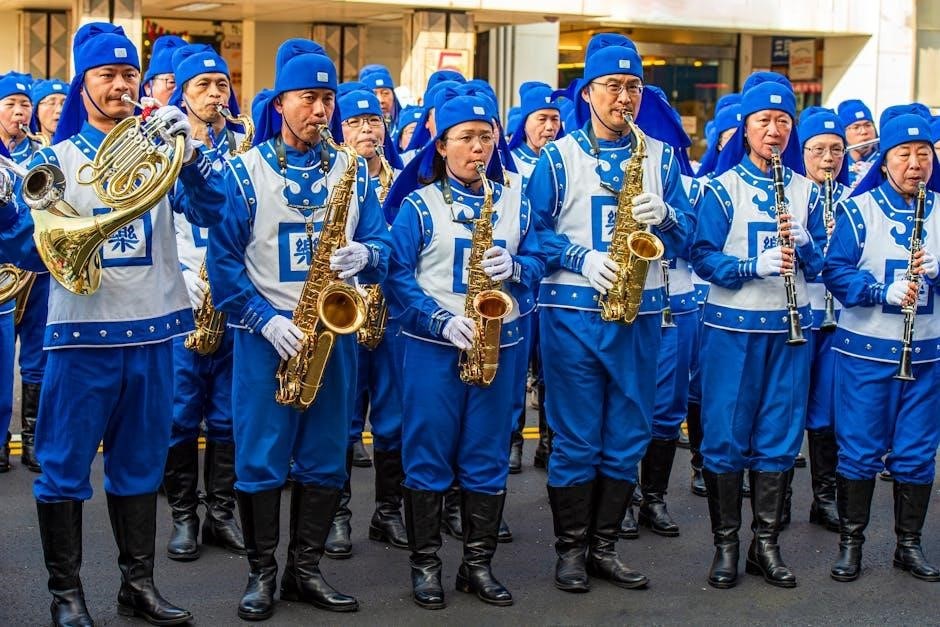
Mozart’s Clarinet Concerto in A major, K․622, is a timeless masterpiece, showcasing the composer’s mastery of instrumental music․ Written for Anton Stadler, it highlights the basset clarinet’s expressive qualities, blending elegance and virtuosity․

Background and History
Mozart composed his Clarinet Concerto in 1791, a year before his death․ It was written in A major, K․ 622, for the basset clarinet․ This concerto is one of Mozart’s last works and remains a cornerstone of clarinet repertoire, celebrated for its lyrical melodies and technical brilliance․ Its composition was likely influenced by Mozart’s friendship with clarinetist Anton Stadler, who premiered the piece․ The concerto’s manuscript was lost after Mozart’s death but was reconstructed from surviving parts, making it a significant historical find․ Today, the concerto is widely performed and admired, with its score available in various formats for study and performance․
2․1 Historical Context
Mozart composed his Clarinet Concerto in 1791, a time of significant personal and financial challenges for the composer․ Despite these difficulties, the concerto reflects Mozart’s mastery of orchestration and his deep understanding of the clarinet’s expressive capabilities․ The work was influenced by the musical tastes of the late 18th century, blending classical balance with romantic expressiveness․ The concerto was written for Anton Stadler, a virtuosic clarinetist and a close friend of Mozart, who played the premiere․ This collaboration likely inspired Mozart to explore the basset clarinet’s extended range, creating a piece that remains a cornerstone of clarinet repertoire․ The concerto’s composition coincided with broader musical innovations, as composers began experimenting with new instrumental techniques and forms․ Its historical significance lies in its innovative use of the clarinet and its enduring popularity as a showcase for the instrument’s lyrical and technical possibilities․
2․2 Commission and Premiere
Mozart’s Clarinet Concerto was commissioned by Anton Stadler, a renowned clarinetist and friend of the composer․ Stadler, known for his virtuosic skills, played a significant role in shaping the concerto’s technical demands․ The premiere took place on October 16, 1791, in Prague, with Stadler performing as the soloist․ This event marked a high point in Mozart’s career, as the concerto was well-received by the audience and critics alike․ The premiere not only showcased the clarinet’s capabilities but also highlighted Mozart’s innovative approach to orchestration․ Interestingly, the original manuscript was lost, and the concerto was reconstructed from surviving parts․ Despite financial struggles, Mozart’s collaboration with Stadler resulted in a work that remains a benchmark for clarinet repertoire․ The concerto’s success in Prague further solidified its place in musical history, making it one of Mozart’s most celebrated compositions․
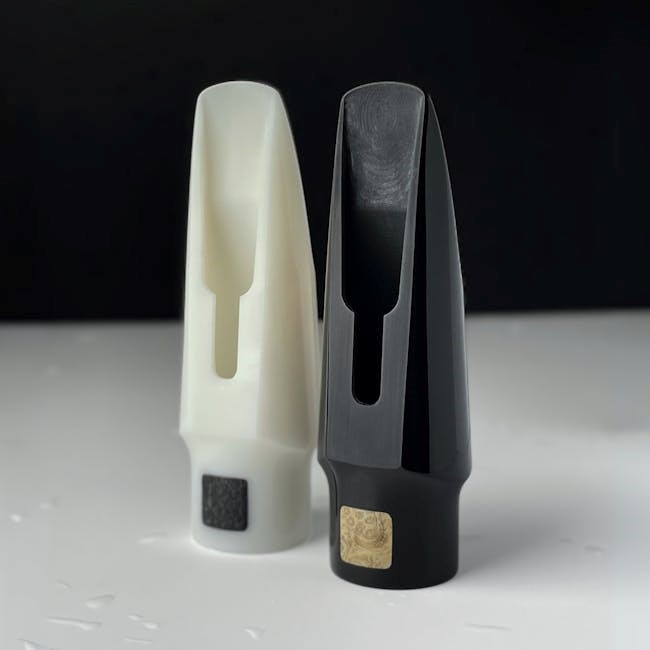
Structure and Movements
Mozart’s Clarinet Concerto is structured in three movements: Allegro, Adagio, and Rondo (Allegro)․ Each movement showcases the clarinet’s expressive range, blending technical brilliance with lyrical beauty, framed by orchestral accompaniment․
3․1 First Movement: Allegro
The first movement of Mozart’s Clarinet Concerto, marked Allegro, is a vibrant and lively opening that sets the tone for the entire work․ Composed in sonata form, it features a dynamic interplay between the solo clarinet and the orchestra․ The movement begins with a bold orchestral introduction, followed by the clarinet’s entrance with a soaring, lyrical theme․ Throughout, Mozart showcases the clarinet’s agility and expressive capabilities, blending technical brilliance with melodic elegance․ The dialogue between the soloist and the orchestra creates a sense of tension and resolution, culminating in a triumphant conclusion․ This movement is renowned for its balance of virtuosity and musicality, making it a cornerstone of the clarinet repertoire․
3․2 Second Movement: Adagio
The Adagio movement of Mozart’s Clarinet Concerto is a masterpiece of lyrical beauty, showcasing the clarinet’s expressive capabilities․ Marked by a slow and contemplative tempo, this movement highlights the instrument’s ability to sing with warmth and elegance․ The clarinet’s melodic lines are accompanied by subtle orchestral textures, creating a sense of intimacy and emotional depth․ Mozart’s writing here is characterized by soaring phrases, nuanced dynamics, and a harmonic richness that underscores the clarinet’s vocal qualities․ The movement follows a sonata-like structure, with themes that unfold naturally, leading to a serene and satisfying resolution․ This Adagio is often praised for its timeless beauty and remains a beloved moment in the concerto, demonstrating Mozart’s profound understanding of the clarinet’s expressive potential․
3․3 Third Movement: Rondo (Allegro)
The third movement of Mozart’s Clarinet Concerto, marked Rondo (Allegro), is a vibrant and lively conclusion to the work․ Characterized by its fast tempo and energetic rhythms, this movement features a recurring main theme (the rondo motif) that alternates with contrasting episodes․ The clarinet showcases its technical agility through intricate passages, while the orchestra provides a dynamic and supportive accompaniment․ The interplay between the soloist and the ensemble creates a sense of dialogue, adding to the movement’s vitality․ Mozart’s mastery of form and melody is evident in the way he balances the recurring theme with episodes that explore different moods and textures․ This movement is a celebration of both the clarinet’s virtuosic capabilities and the composer’s ability to craft music that is both engaging and sophisticated, bringing the concerto to a triumphant close․
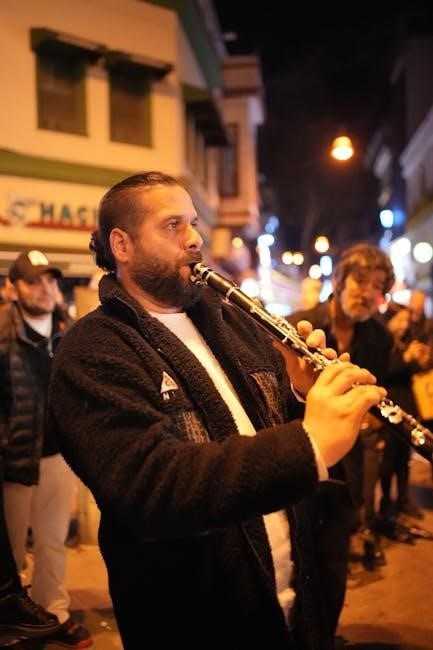
Key and Tonality
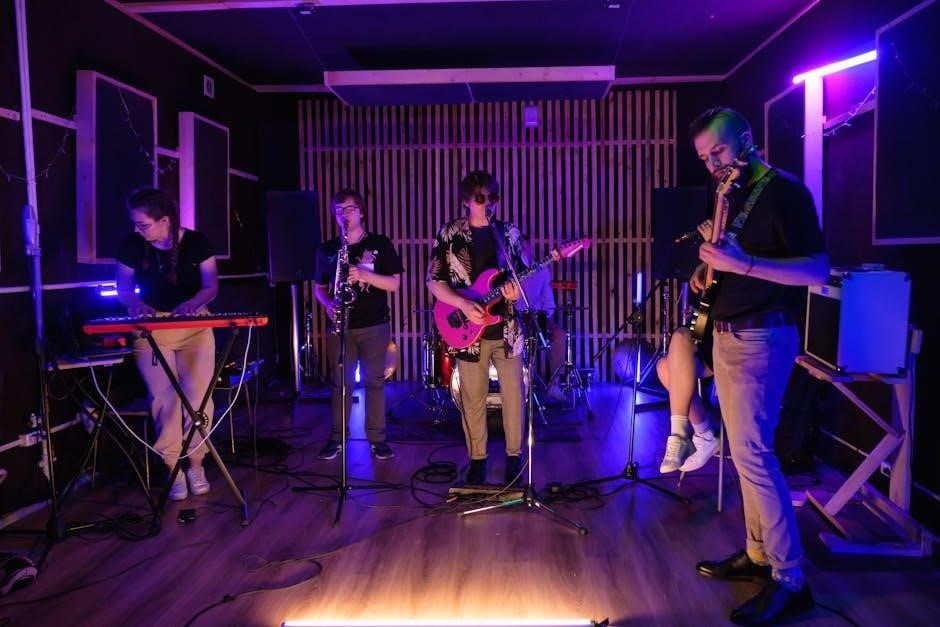
Mozart’s Clarinet Concerto is written in A major, a key that offers clarity and brilliance, complementing the clarinet’s warm tones․ The tonality provides harmonic balance and structural coherence, enhancing the work’s lyrical and virtuosic elements;
4․1 Choice of Key
Mozart’s Clarinet Concerto is composed in A major, a key that beautifully complements the clarinet’s warm and expressive qualities․ This choice was strategic, as A major provides a bright and clear timbre, allowing the clarinet to project effortlessly over the orchestral accompaniment․ The key also aligns with the technical capabilities of the basset clarinet, which Mozart originally wrote the concerto for․ A major’s harmonic structure offers a balance between lyrical passages and virtuosic demands, making it an ideal choice for showcasing both the instrument’s agility and emotional depth․ Additionally, the key’s tonal stability allows for rich harmonic exploration, enhancing the concerto’s musical complexity and appeal․ This deliberate selection underscores Mozart’s mastery in tailoring his compositions to the unique characteristics of the instruments he wrote for․
4․2 Implications for Performance
The choice of A major in Mozart’s Clarinet Concerto has significant implications for performance․ The key’s bright and resonant quality demands precise intonation and control from the clarinetist, particularly in the upper registers; Performers must also navigate the technical demands of the concerto, including intricate passagework and lyrical melodies, all while maintaining a balance with the orchestral accompaniment․ The basset clarinet’s extended lower range, for which the concerto was originally written, adds another layer of challenge, as modern clarinetists often adapt the piece to standard instruments․ Additionally, the tonal clarity of A major requires careful attention to phrasing and dynamics to ensure the soloist’s voice is heard above the ensemble․ These factors make the concerto a benchmark for clarinetists, testing both technical proficiency and musical expression․ The key’s harmonic stability also allows for expressive freedom, enabling performers to interpret the work with nuance and emotion․

The Basset Clarinet
Mozart’s Clarinet Concerto was originally composed for the basset clarinet, an extended version of the standard clarinet with a deeper range, offering a richer, warmer tonal quality․
5․1 Role in the Concerto
The basset clarinet plays a central role in Mozart’s Clarinet Concerto, showcasing its unique timbre and extended range․ Composed specifically for this instrument, the concerto highlights the basset clarinet’s ability to produce rich, warm tones in its lower register․ Mozart exploited the instrument’s expressive qualities, creating melodies that flow seamlessly across its range․ The basset clarinet’s deeper notes add depth to the concerto’s texture, while its upper register provides clarity and agility․ This tailored composition underscores Mozart’s appreciation for the instrument’s capabilities, making it a cornerstone of the clarinet repertoire․ The basset clarinet’s role is not merely soloistic but also integrative, blending with the orchestra to create a balanced and cohesive musical experience․ Its presence defines the concerto’s character, offering a blend of lyricism and technical brilliance that continues to inspire performers and audiences alike․
5․2 Reconstruction Efforts
Reconstructing Mozart’s Clarinet Concerto has been a significant task due to the loss of the original basset clarinet parts․ Scholars have relied on secondary sources, including surviving piano reductions and orchestral parts, to piece together the concerto․ Efforts to recreate the basset clarinet itself have involved studying historical instruments and manufacturing techniques․ Modern clarinetists often use reconstructed basset clarinets or adapt standard clarinets to mimic its extended range․ Additionally, editors have worked to reconcile discrepancies in the surviving manuscripts, ensuring the score remains faithful to Mozart’s intentions․ These reconstruction efforts have preserved the concerto’s historical integrity, allowing contemporary performers to interpret the work as closely as possible to its original form․ The collaboration between historians, instrument makers, and musicians has been essential in keeping this masterpiece alive and accessible for future generations․
Availability of Sheet Music
Mozart’s Clarinet Concerto sheet music is widely available in PDF format from online libraries, music stores, and educational platforms․ Both free and paid versions can be accessed easily․
6․1 PDF Sources
Mozart’s Clarinet Concerto in A Major, K․ 622, is widely available in PDF format from reputable online sources․ The International Music Score Library Project (IMSLP) offers a comprehensive collection of scores, including the concerto in its original form․ Musopen and other classical music archives also provide free PDF downloads․ Many music schools and libraries host downloadable versions for educational purposes․ Additionally, commercial platforms like Musicnotes and Sheet Music Plus offer high-quality PDF editions, often with optional transpositions or piano reductions․ Clarinetists can also find PDFs tailored to specific needs, such as solo parts with orchestral reductions or cadenzas․ These sources ensure accessibility for performers, educators, and enthusiasts alike, making the concerto readily available for study and performance․
6;2 Editions and Transpositions
Mozart’s Clarinet Concerto is available in various editions and transpositions, catering to different performance needs․ The original version, written for the basset clarinet, is often transposed to suit the standard clarinet in A or B-flat․ Many publishers offer urtext editions, which strive to present the composer’s original intent without editorial alterations; These editions are particularly valued by scholars and performers seeking authenticity․ Additionally, there are transposed versions for clarinet in different keys, such as E-flat or C, to accommodate specific instrumental preferences or technical requirements․ Some editions also include cadenzas by renowned clarinetists, offering interpretative insights․ These diverse editions ensure that the concerto remains accessible and adaptable for clarinetists of all levels, while preserving its artistic integrity and historical significance․
Performances and Interpretations
The concerto’s emotional depth invites diverse interpretations, with clarinetists like Sabine Meyer and Martin Fröst offering unique stylistic approaches, enriching its legacy through varied performances and dynamic orchestral interactions․
7․1 Orchestral Accompaniment
Mozart’s Clarinet Concerto features a refined orchestral accompaniment that perfectly complements the clarinet’s lyrical and technical demands․ The orchestra, comprising strings, woodwinds, brass, and percussion, creates a balanced and supportive texture․ The strings provide harmonic richness and rhythmic foundation, while the woodwinds, including flutes, oboes, and bassoons, add timbral diversity․ Brass instruments, such as horns and trumpets, are used sparingly but effectively to enhance key moments․ The percussion section, though minimal, contributes to dramatic accents․ Mozart’s orchestration ensures the clarinet remains a foreground voice, with the orchestra often mirroring or responding to its melodies․ This interplay fosters a dialogue between soloist and ensemble, heightening the concerto’s emotional impact․ The orchestral accompaniment is both sensitive and dynamic, reflecting Mozart’s mastery of orchestration and his ability to create a cohesive musical experience․
7․2 Notable Performances
Mozart’s Clarinet Concerto has been performed by countless renowned clarinetists, each bringing their unique interpretation to the piece․ One of the most celebrated recordings is by Benny Goodman, whose technical precision and expressive playing set a benchmark for future performers․ Another notable interpretation is by Sabine Meyer, whose lyrical approach and nuanced phrasing highlight the concerto’s melodic beauty․ Clarinetists like Martin Fröst and Yoona Choi have also delivered memorable performances, blending technical brilliance with emotional depth․ These renditions showcase the concerto’s versatility and enduring appeal․ Each artist’s interpretation offers a fresh perspective, ensuring the piece remains a cornerstone of classical music repertoire․ The concerto’s timeless charm continues to inspire new generations of musicians and audiences alike, solidifying its place as one of Mozart’s most beloved works․
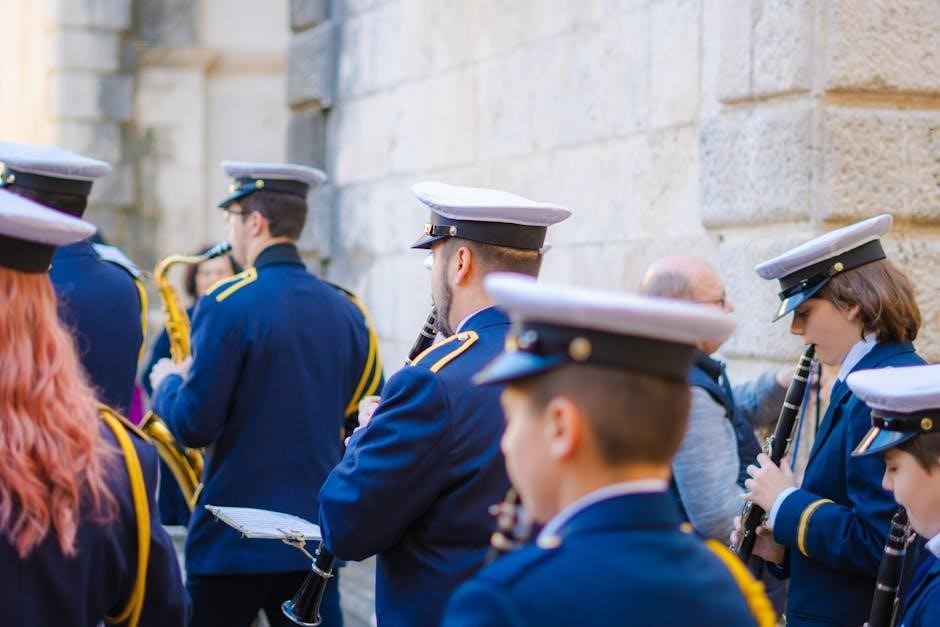
Musical Analysis
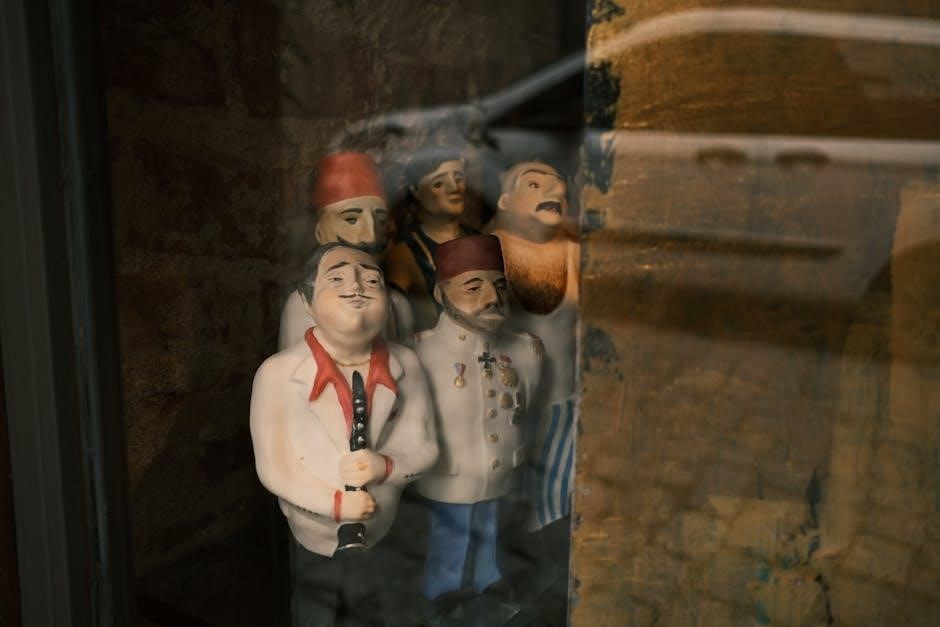
Mozart’s Clarinet Concerto exemplifies a refined balance between the soloist and orchestra, with intricate thematic development and harmonic richness, showcasing the clarinet’s expressive capabilities in a classical framework․
8․1 Thematic Development
Mozart’s Clarinet Concerto is renowned for its masterful thematic development, where melodic ideas are introduced, elaborated, and transformed across movements․ The first movement, Allegro, begins with a robust orchestral theme, setting the foundation for the clarinet’s entry with a lyrical, expansive melody․ This theme is woven throughout the movement, undergoing subtle variations and harmonic shifts that showcase Mozart’s compositional genius․ The development section is particularly notable for its exploration of motivic fragments, creating a sense of tension and resolution․ The Adagio movement features a beautiful, cantabile theme that highlights the clarinet’s expressive qualities, while the Rondo finale introduces a lively, rhythmic motif that undergoes playful variations․ Throughout the concerto, Mozart’s ability to maintain thematic coherence while exploring a wide range of emotional and technical possibilities is evident, making the work a cornerstone of the clarinet repertoire․
8․2 Cadenza Options
The cadenzas in Mozart’s Clarinet Concerto are a focal point for soloistic expression, offering clarinetists the opportunity to showcase technical prowess and interpretive creativity․ While Mozart provided sketchy outlines for the cadenzas, the final versions were likely completed by others, including clarinetist Anton Stadler, for whom the concerto was written․ Over time, multiple cadenzas have been composed by renowned clarinetists and composers, each offering unique stylistic interpretations․ Performers often choose cadenzas that align with their technical abilities and artistic vision, adding a personal touch to the concerto․ Historical performances tend to favor period-appropriate cadenzas, while modern interpretations may incorporate more virtuosic or contemporary approaches․ The variety of cadenza options ensures that each performance of the concerto remains fresh and distinctive, highlighting the timeless appeal of Mozart’s masterpiece․

Download and Resources
Mozart’s Clarinet Concerto sheet music is widely available in PDF format from platforms like IMSLP and Musicnotes․ Various editions and transpositions cater to different instrumental needs․
9․1 Free Downloads
Free PDF downloads of Mozart’s Clarinet Concerto are accessible through various online platforms, such as the International Music Score Library Project (IMSLP), offering high-quality sheet music․ These downloads typically include the full score and individual parts, making them ideal for performers and educators․ Many websites provide these resources free of charge due to the concerto’s public domain status․ Additionally, some educational institutions and classical music archives share downloadable versions for study and performance purposes․ When downloading, ensure the source is reputable to maintain musical accuracy and quality․ While free downloads are convenient, consider supporting composers and publishers by purchasing official editions when possible․ These resources are invaluable for musicians seeking to explore and perform this beloved concerto․
9․2 MIDI and Audio Resources
MIDI and audio resources for Mozart’s Clarinet Concerto are widely available online, offering musicians valuable tools for practice and performance․ MIDI files provide instrumental parts and orchestral accompaniments, enabling soloists to rehearse with virtual ensembles․ Websites like MuseScore and classical music archives often host these files, allowing for customization and tempo adjustments․ Audio recordings, including high-quality MP3s and WAV files, are accessible on platforms like YouTube, Spotify, and iTunes, featuring performances by renowned artists․ These recordings serve as excellent references for interpreting the concerto․ Some educational institutions and orchestras also offer free audio resources for study purposes․ While MIDI files are often free, premium audio recordings may require purchase or subscription․ These resources are indispensable for clarinetists seeking to refine their technique and deepen their understanding of Mozart’s masterpiece․
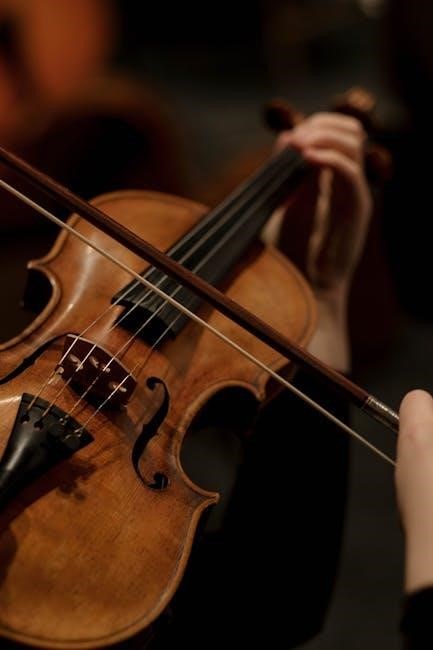
Significance and Legacy
Mozart’s Clarinet Concerto is a cornerstone of classical music, blending lyricism and virtuosity․ Its timeless appeal influences composers and remains a staple in clarinet repertoire, cherished by performers and audiences worldwide․
10․1 Place in Repertoire
Mozart’s Clarinet Concerto holds a revered position in classical music repertoire, celebrated for its masterful blend of technical brilliance and emotional depth․ Composed in 1791, it remains a cornerstone of clarinet literature, showcasing the instrument’s expressive capabilities․ Its enduring popularity stems from its balanced structure, lyrical melodies, and innovative use of the basset clarinet․ The concerto is a staple in orchestral programming and a favorite among clarinetists, offering both technical challenges and opportunities for artistic interpretation․ Its influence extends beyond the classical era, inspiring countless arrangements and transcriptions․ As a testament to Mozart’s genius, the concerto continues to captivate audiences and solidify its place as one of the most essential works in the clarinet repertoire․
10․2 Educational Value
Mozart’s Clarinet Concerto is a vital resource for music education, offering rich opportunities for study and performance․ Its intricate phrasing, nuanced dynamics, and expressive melodies provide clarinetists with a comprehensive technical and interpretative challenge․ Students often analyze the concerto to understand Classical-era composition techniques, such as thematic development and harmonic structure․ The work also serves as a model for orchestration, highlighting the clarinet’s unique timbre within an ensemble․ Music theorists and historians study its historical significance, while performers gain insights into period-specific instrumentation and performance practices․ Additionally, the concerto’s emotional depth encourages students to explore phrasing and articulation, making it a cornerstone of conservatory curricula․ Its availability in PDF formats facilitates access for scholars and learners worldwide, ensuring its educational impact endures․